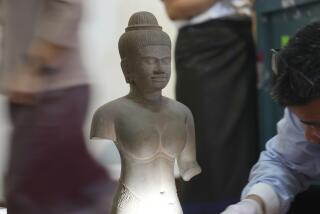A Key Monument to Horror Is Laid to Rest in Cambodia
- Share via
PHNOM PENH, Cambodia — Skull by human skull, officials began Sunday to dismantle a key memorial to the victims of atrocities committed by Cambodia’s former Khmer Rouge rulers.
Buddhist monks prayed for the 300 victims of the Marxist regime whose remains were part of a map of Cambodia made of skulls and displayed since 1979 as a testament to the regime’s brutality. Museum officials said the skulls were decaying.
Hundreds of thousands of Cambodian and foreign visitors to the Tuol Sleng Genocide Museum in Phnom Penh had viewed the grisly, 129-square-foot wall installation of skulls and bones.
More than a million Cambodians died during the 1975-79 rule of the radical regime because of disease, starvation, overwork and execution. Leader Pol Pot died in 1998, but many of his top lieutenants live freely in Cambodia after reaching defection deals with Prime Minister Hun Sen’s government.
The museum is at a school the Khmer Rouge used as its chief prison and torture center. The site was preserved by the Vietnamese army, which deposed the regime and occupied Cambodia for 10 years.
Youk Chhang, director of the Documentation Center of Cambodia, which has been gathering evidence of Khmer Rouge atrocities for eight years, said he supported the removal of the skull map.
“Cambodians and foreigners should be educated about the tragic past, but publicity like this is not necessary. Scientific explanation does more to help people understand,” he said.
The empty place on the wall will be replaced by a large map of Cambodia, identifying mass graves and prisons of the Khmer Rouge regime. A photograph of the skull map will also be displayed.
Cambodians have long debated the appropriateness of displaying victims’ remains in memorials. Cambodia’s king wants the bones cremated, but Hun Sen contends that memories of Khmer Rouge evils must be preserved to educate future generations.
More to Read
Sign up for Essential California
The most important California stories and recommendations in your inbox every morning.
You may occasionally receive promotional content from the Los Angeles Times.













